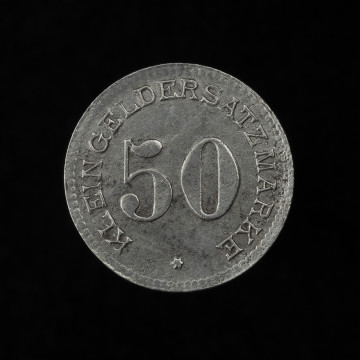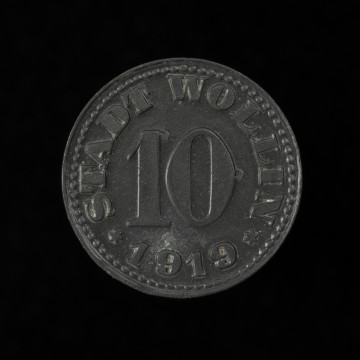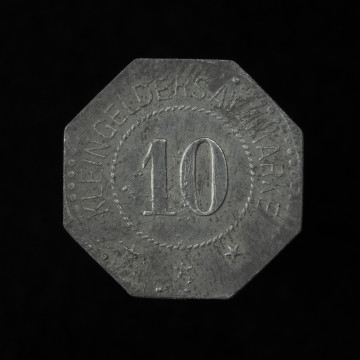
50 pfennig
1901 — 1925
National Museum in Szczecin
Part of the collection: Scrip
Although physical money is now being displaced by non-cash transactions, it nevertheless continues to be a part of trade. More than a century ago, despite the fact that cheques were used on a large scale and cashless transfers were commonplace, cash played a crucial role in the retail trade. In a context at which cash by way of small coins is the foundation of circulation, a sudden shortage could paralyse retail trade. This was the problem in Germany during the First World War. Not only did silver money disappear from circulation, but so did low denomination pfennig currency that was minted using common metals. In particular, the public hoarded 10 pfennig coins used for gas and electric meters, common in many households at the time. The national mints could not meet demand, and given that the circulation shortage was particularly acute in the rural areas, the issuing of small coins was taken into the hands of local authorities, including the town of Polzin (now Połczyn-Zdrój). In 1919, the company Jörgum & Trefz in Frankfurt am Main was commissioned by the magistrate of Polzin to mint two batches of 5-pfennig coins in zinc and iron. The iron ones had a slightly smaller diameter and a slightly altered obverse design. A total of five varieties of these are known, differing mainly in the length of the denomination name and the finish of some of them, brassed in a light yellow or reddish colour. The electroplating of the discs with brass was probably intended to ensure the durability of the coins, while the colour may have had to do with the manufacturer obtaining material with different copper content. Hence, the reddish colour of the featured 5 pfennig coin indicates a higher content of this element. The unavailability of raw material with a constant content of metal compounds was unlikely to have been planned by the issuer. However, the disadvantage of this mass issue turned out to be a benefit for later collectors, for whom every discrepancy within an issue increases the value of a coin. Mieszko Pawłowski
Other names
5 Pfennig, Notgeld
Author / creator
Object type
token coin
Technique
coining, brass coating
Material
iron
Origin / acquisition method
purchase
Creation time / dating
Creation / finding place
Owner
Muzeum Narodowe w Szczecinie (1945- )
Identification number
Location / status

1901 — 1925
National Museum in Szczecin

1919
National Museum in Szczecin

circa 1917
National Museum in Szczecin
DISCOVER this TOPIC
Museum of King Jan III's Palace at Wilanów
DISCOVER this PATH
Educational path